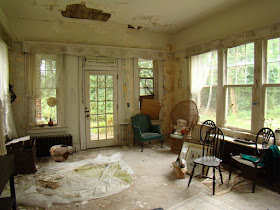LISTING DETAILS
The historic Page Mansion, circa 1913 on 8.8 acres, is an exquisite home in need of some major TLC to bring it back to its glamorous past as one of the most beautiful homes in the County. There is a special use permit (see docs) for use as Wedding/Events Venue (event center). This lovely 6,000+ sq ft brick mansion features a large central foyer, staircase, formal parlors and dining rooms on the main floor and 6 bedrooms on the second floor. Three Fireplaces. Servants quarters on second floor with a back staircase that leads directly to the kitchen and another staircase to access the huge walk up attic. Contractor has estimates for repairs. Truly a special property. Bordered by both Residential and commercial uses. Valuable subdivision land. Seller will partner on a project or renovate for cost +5%. Broker/owner
Currently on Septic but public sewer is at street.
Untouched for decades, a mansion with
a backstory and aesthetic appeal worthy of Hollywood is the newest old
kid on the block in Aberdeen.
The massive brick manor — protected and hidden by acres of overgrown trees and landscaping — was nearly forgotten to time until a local builder stepped in recently to reimagine the home as a special event and wedding venue.
Built in 1913, it is one of only a few historic Page family homes that hearken back to a time when wealthy industrialists transformed the local landscape.
A migration of Highland Scots first began settling the Sandhills region in the mid 1700s. Miles of pine-forested lands near the headwaters of Rockfish Creek gave rise to a community called Blue’s Crossing, named after Malcolm McMillian Blue. He tapped the trees for tar, pitch and turpentine around 1850. Following the Civil War, a railroad track and local station encouraged growth in the area’s economy.
In 1880, Allison Francis “Frank” Page began purchasing great tracts of pines and established a lumber mill on Devil’s Gut Creek, later known as Aberdeen Creek. A dam on the creek created Aberdeen Lake and powered a sawmill and gristmill. Between turpentine and timber, the region flourished, and Blue’s Crossing was incorporated and renamed Aberdeen in homage to its Scottish heritage.
Page
built a large frame home for his family on a hill that overlooks
Aberdeen Lake — an area that became known as Page Hill. As many as 11
homes were built on Page Hill for his eight children and their families.
Famed architect J.M.
McMichael was commissioned to design a home on Page Hill for
Frances J. Page, a daughter of Allison and Catherine Page. She had
married a lawyer, Thomas Bonner Wilder, of Louisburg, nearly a decade
earlier, and the family quickly grew to include seven children.
The beautiful 6,000-plus-square-foot brick home was built on eight acres in 1913, along Allison Page Road. McMichael designed the house around a traditional center hall with a grand staircase, formal parlors and dining rooms on the main floor. The second floor boasts six bedrooms, plus servants’ quarters with its own set of steps leading directly to the kitchen and butler’s pantry.
Unfortunately,
the Wilders’ sole legacy is their home. Little else was left behind to
tell their story. The Great Depression wiped out many families,
including wealthy industrialists like the Pages and Wilders. The grand
home was in decline by the 1950s, when it was sold to Dr. F.B. and Ruby
Bishop.
Dr. Bishop was a
retired minister of the Unitarian Universalist Church and his wife was a
grammar school teacher, who taught in Aberdeen schools for 30 years.
The couple brought with them their two young children, Roy and Elva.
Over the years, [they] made minor fixes to the house but never undertook any major
renovations. The unintended result is a nearly perfect time capsule.
Stepping onto the deep front porch, the house draws you in. Rooms left with period furnishings are significant by themselves. The Bishops purchased much of their furniture and art from an auction at the Campbell House in Southern Pines as it was transitioning to a culture and arts center for the community.
[When Ruby died, Elva bought out Roy, who wanted to sell the house. Elva intended to move back to the house one day, but after retirement she found herself traveling rather than living in the home. Elva had many offers over the years to sell to developers, but refused those offers as it would include a tear down of the house. When Allan Casavant, a childhood friend of Roy's, came inquiring about the house, Elva agreed to sell to him because he wanted to restore the house.]
A
top-to-bottom rehabilitation is in order, but the bones of the house
will endure; the goal is to maintain the historically accurate appeal.
Rough plans include converting a section of the yard as an outdoor venue
space, installing a large semi-circular porch to the rear of the home,
building an outdoor pavilion, and adding a catering kitchen.
Initial renovation efforts are focused on clearing out overgrown landscaping around the house and repairs where needed to the exterior. Casavant said the slate roof is mostly in good shape, but some damaged areas will be repaired. More substantial work inside includes replacing all the galvanized pipes and upgrading the electrical wiring to handle modern HVAC equipment.
FOR SALE $425,000
260 Allison Page Rd, Aberdeen, NC 28315
6 beds | 4 baths | 6200 sqft | 8.8 acres
LINKS:
Listing Agent, Zillow, Realtor, Article via The Pilot,
Featured Photos
 | |
| via The Pilot |
 | |
| via The Pilot |
 | |
| via The Pilot |
 | |
| via The Pilot |
 | |
| via The Pilot |
 | |
| via The Pilot |
 | |
| Via The Pilot |
 | |
| via The Pilot |
























No comments:
Post a Comment